https://github.com/ChenCurry/test_struts2/tree/hibernate
orm框架
(object relationg mapping对象关系映射)
(分4级)
dbutils属于1级
mybatis属于2级
hibernate属于4级:完全面向对象操作数据库
导包
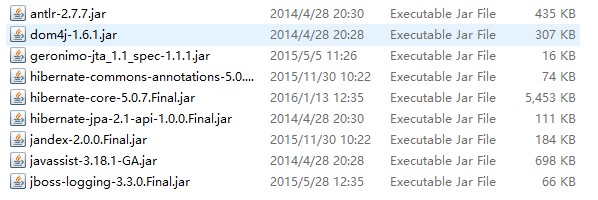
驱动包
![]()
创建数据库/表
书写orm元数据配置
(对象与表的映射配置文件)
导入约束
(有两种导入约束的方式,这两种情况分别是在有网和没网的情况下分别操作的)
/org/hibernate/hibernate-configuration-3.0.dtd
/org/hibernate/hibernate-mapping-3.0.dtd
(hibernate-core-5.0.7.Final.jar中)


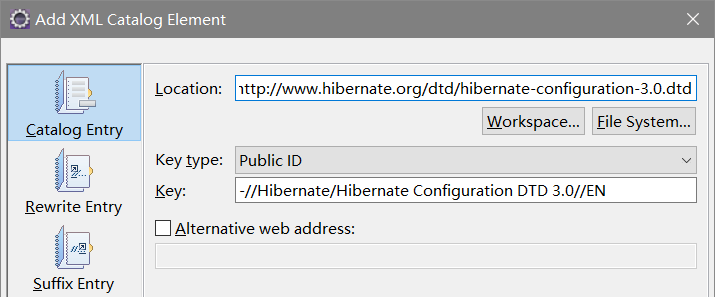
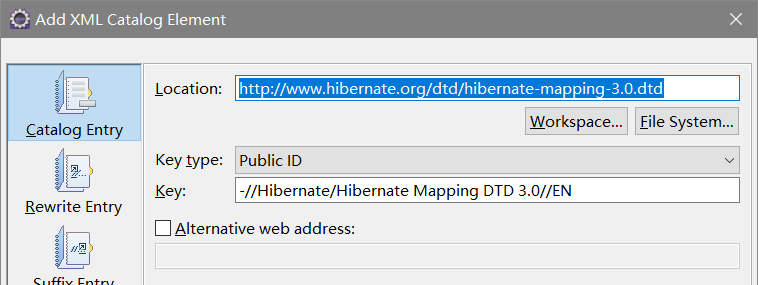
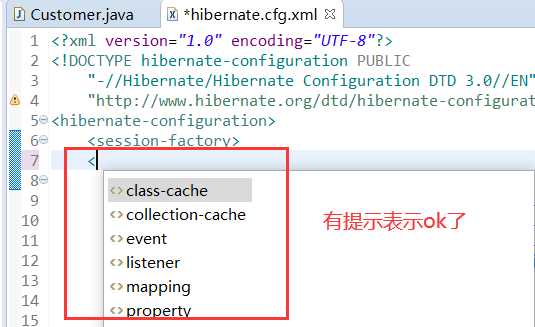

(玛德,复现不了,尝试用离线方式)


(终于得行了,蓝瘦!)
实体Customer
public class Customer { /* * CREATE TABLE `cst_customer` ( `cust_id` BIGINT(32) NOT NULL AUTO_INCREMENT COMMENT '客户编号(主键)', `cust_name` VARCHAR(32) NOT NULL COMMENT '客户名称(公司名称)', `cust_source` VARCHAR(32) DEFAULT NULL COMMENT '客户信息来源', `cust_industry` VARCHAR(32) DEFAULT NULL COMMENT '客户所属行业', `cust_level` VARCHAR(32) DEFAULT NULL COMMENT '客户级别', `cust_linkman` VARCHAR(64) DEFAULT NULL COMMENT '联系人', `cust_phone` VARCHAR(64) DEFAULT NULL COMMENT '固定电话', `cust_mobile` VARCHAR(16) DEFAULT NULL COMMENT '移动电话', PRIMARY KEY (`cust_id`) ) ENGINE=INNODB AUTO_INCREMENT=1 DEFAULT CHARSET=utf8; */ private Long cust_id; private String cust_name; private String cust_source; private String cust_industry; private String cust_level; private String cust_linkman; private String cust_phone; private String cust_mobile; public Long getCust_id() { return cust_id; } public void setCust_id(Long cust_id) { this.cust_id = cust_id; } public String getCust_name() { return cust_name; } public void setCust_name(String cust_name) { this.cust_name = cust_name; } public String getCust_source() { return cust_source; } public void setCust_source(String cust_source) { this.cust_source = cust_source; } public String getCust_industry() { return cust_industry; } public void setCust_industry(String cust_industry) { this.cust_industry = cust_industry; } public String getCust_level() { return cust_level; } public void setCust_level(String cust_level) { this.cust_level = cust_level; } public String getCust_linkman() { return cust_linkman; } public void setCust_linkman(String cust_linkman) { this.cust_linkman = cust_linkman; } public String getCust_phone() { return cust_phone; } public void setCust_phone(String cust_phone) { this.cust_phone = cust_phone; } public String getCust_mobile() { return cust_mobile; } public void setCust_mobile(String cust_mobile) { this.cust_mobile = cust_mobile; } @Override public String toString() { return "Customer [cust_id=" + cust_id + ", cust_name=" + cust_name + "]"; } }
orm元数据配置Customer.hbm.xml
<?xml version="1.0" encoding="UTF-8"?> <!DOCTYPE hibernate-mapping PUBLIC "-//Hibernate/Hibernate Mapping DTD 3.0//EN" "http://www.hibernate.org/dtd/hibernate-mapping-3.0.dtd"> <!-- 配置表与实体对象的关系 --> <!-- package属性:填写一个包名.在元素内部凡是需要书写完整类名的属性,可以直接写简答类名了. --> <hibernate-mapping package="cn.itheima.domain" > <!-- class元素: 配置实体与表的对应关系的 name: 完整类名 table:数据库表名 --> <class name="Customer" table="cst_customer" > <!-- id元素:配置主键映射的属性 name: 填写主键对应属性名 column(可选): 填写表中的主键列名.默认值:列名会默认使用属性名 type(可选):填写列(属性)的类型.hibernate会自动检测实体的属性类型. 每个类型有三种填法: java类型|hibernate类型|数据库类型 not-null(可选):配置该属性(列)是否不能为空. 默认值:false length(可选):配置数据库中列的长度. 默认值:使用数据库类型的最大长度 --> <id name="cust_id" > <!-- generator:主键生成策略(明天讲) --> <generator class="native"></generator> </id> <!-- property元素:除id之外的普通属性映射 name: 填写属性名 column(可选): 填写列名 type(可选):填写列(属性)的类型.hibernate会自动检测实体的属性类型. 每个类型有三种填法: java类型|hibernate类型|数据库类型 not-null(可选):配置该属性(列)是否不能为空. 默认值:false length(可选):配置数据库中列的长度. 默认值:使用数据库类型的最大长度 --> <property name="cust_name" column="cust_name" > <!-- <column name="cust_name" sql-type="varchar" ></column> --> </property> <property name="cust_source" column="cust_source" ></property> <property name="cust_industry" column="cust_industry" ></property> <property name="cust_level" column="cust_level" ></property> <property name="cust_linkman" column="cust_linkman" ></property> <property name="cust_phone" column="cust_phone" ></property> <property name="cust_mobile" column="cust_mobile" ></property> </class> </hibernate-mapping>
主配置文件hibernate.cfg.xml
<?xml version="1.0" encoding="UTF-8"?> <!DOCTYPE hibernate-configuration PUBLIC "-//Hibernate/Hibernate Configuration DTD 3.0//EN" "http://www.hibernate.org/dtd/hibernate-configuration-3.0.dtd"> <hibernate-configuration> <session-factory> <!-- #hibernate.dialect org.hibernate.dialect.MySQLDialect #hibernate.dialect org.hibernate.dialect.MySQLInnoDBDialect #hibernate.dialect org.hibernate.dialect.MySQLMyISAMDialect #hibernate.connection.driver_class com.mysql.jdbc.Driver #hibernate.connection.url jdbc:mysql:///test #hibernate.connection.username gavin #hibernate.connection.password --> <!-- 数据库驱动 --> <property name="hibernate.connection.driver_class">com.mysql.jdbc.Driver</property> <!-- 数据库url --> <property name="hibernate.connection.url">jdbc:mysql:///hibernate_32</property> <!-- 数据库连接用户名 --> <property name="hibernate.connection.username">root</property> <!-- 数据库连接密码 --> <property name="hibernate.connection.password">root</property> <!-- 数据库方言 不同的数据库中,sql语法略有区别. 指定方言可以让hibernate框架在生成sql语句时.针对数据库的方言生成. sql99标准: DDL 定义语言 库表的增删改查 DCL 控制语言 事务 权限 DML 操纵语言 增删改查 注意: MYSQL在选择方言时,请选择最短的方言. --> <property name="hibernate.dialect">org.hibernate.dialect.MySQLDialect</property> <!-- #hibernate.show_sql true #hibernate.format_sql true --> <!-- 将hibernate生成的sql语句打印到控制台 --> <property name="hibernate.show_sql">true</property> <!-- 将hibernate生成的sql语句格式化(语法缩进) --> <property name="hibernate.format_sql">true</property> <!-- ## auto schema export 自动导出表结构. 自动建表 #hibernate.hbm2ddl.auto create 自动建表.每次框架运行都会创建新的表.以前表将会被覆盖,表数据会丢失.(开发环境中测试使用) #hibernate.hbm2ddl.auto create-drop 自动建表.每次框架运行结束都会将所有表删除.(开发环境中测试使用) #hibernate.hbm2ddl.auto update(推荐使用) 自动生成表.如果已经存在不会再生成.如果表有变动.自动更新表(不会删除任何数据). #hibernate.hbm2ddl.auto validate 校验.不自动生成表.每次启动会校验数据库中表是否正确.校验失败. --> <property name="hibernate.hbm2ddl.auto">update</property> <!-- 指定hibernate操作数据库时的隔离级别 #hibernate.connection.isolation 1|2|4|8 0001 1 读未提交 0010 2 读已提交 0100 4 可重复读 1000 8 串行化 --> <property name="hibernate.connection.isolation">4</property> <!-- 指定session与当前线程绑定 --> <property name="hibernate.current_session_context_class">thread</property> <!-- 引入orm元数据 路径书写: 填写src下的路径 --> <mapping resource="cn/itheima/domain/Customer.hbm.xml" /> <mapping resource="cn/itheima/domain/LinkMan.hbm.xml" /> <mapping resource="cn/itheima/domain/Userx.hbm.xml" /> </session-factory> </hibernate-configuration>
测试代码
import org.hibernate.Session; import org.hibernate.SessionFactory; import org.hibernate.Transaction; import org.hibernate.cfg.Configuration; import org.junit.Test; import cn.itheima.domain.Customer; //测试Hibernate框架 public class H1Demo { @Test //保存客户 public void fun1(){ Configuration conf = new Configuration().configure(); SessionFactory sessionFactory = conf.buildSessionFactory(); Session session = sessionFactory.openSession(); Transaction tx = session.beginTransaction(); //---------------------------------------------- Customer c = new Customer(); c.setCust_name("google公司"); session.save(c);//执行保存 //---------------------------------------------- tx.commit(); session.close(); sessionFactory.close(); } }
Configuration对象
import org.hibernate.Session; import org.hibernate.SessionFactory; import org.hibernate.Transaction; import org.hibernate.cfg.Configuration; import org.junit.Test; import cn.itheima.domain.Customer; //学习Configuration对象 // Configuration功能: 配置加载类.用于加载主配置,orm元数据加载 public class H1Demo1 { @Test public void fun1(){ //1 创建,调用空参构造 Configuration conf = new Configuration(); //2 读取指定主配置文件 => 空参加载方法,加载src下的hibernate.cfg.xml文件 conf.configure(); //3 读取指定orm元数据(扩展),如果主配置中已经引入映射配置.不需要手动加载 //conf.addResource(resourceName); //conf.addClass(persistentClass); //4 根据配置信息,创建 SessionFactory对象 SessionFactory sf = conf.buildSessionFactory(); } }
SessionFactory对象
import org.hibernate.Session; import org.hibernate.SessionFactory; import org.hibernate.Transaction; import org.hibernate.cfg.Configuration; import org.junit.Test; import cn.itheima.domain.Customer; //学习SessionFactory对象 // SessionFactory功能: 用于创建操作数据库核心对象session对象的工厂. // 简单说功能就一个---创建session对象 //注意:1.sessionfactory 负责保存和使用所有配置信息.消耗内存资源非常大. // 2.sessionFactory属于线程安全的对象设计. //结论: 保证在web项目中,只创建一个sessionFactory. public class H1Demo2 { @Test public void fun1(){ //1 创建,调用空参构造 Configuration conf = new Configuration(); //2 读取指定主配置文件 => 空参加载方法,加载src下的hibernate.cfg.xml文件 conf.configure(); //3 读取指定orm元数据(扩展),如果主配置中已经引入映射配置.不需要手动加载 //conf.addResource(resourceName); //conf.addClass(persistentClass); //4 根据配置信息,创建 SessionFactory对象 SessionFactory sf = conf.buildSessionFactory(); //-------------------------------------------------- //5 获得session //打开一个新的session对象 sf.openSession(); //获得一个与线程绑定的session对象(明天讲解) sf.getCurrentSession(); } }
Session对象:crud
import org.hibernate.Session; import org.hibernate.SessionFactory; import org.hibernate.Transaction; import org.hibernate.cfg.Configuration; import org.junit.Test; import cn.itheima.domain.Customer; //学习Session对象 //session对象功能: 表达hibernate框架与数据库之间的连接(会话).session类似于 // JDBC年代的connection对象. 还可以完成对数据库中数据的增删改查操作. // session是hibernate操作数据库的核心对象 public class H1Demo3 { @Test //事务操作 public void fun1(){ //1 创建,调用空参构造 Configuration conf = new Configuration().configure(); //2 根据配置信息,创建 SessionFactory对象 SessionFactory sf = conf.buildSessionFactory(); //3 获得session Session session = sf.openSession(); //4 session获得操作事务的Transaction对象 //获得操作事务的tx对象 //Transaction tx = session.getTransaction(); //开启事务并获得操作事务的tx对象(建议使用) Transaction tx2 = session.beginTransaction(); //---------------------------------------------- //---------------------------------------------- tx2.commit();//提交事务 tx2.rollback();//回滚事务 session.close();//释放资源 sf.close();//释放资源 } @Test //session的新增 public void fun2(){ //1 创建,调用空参构造 Configuration conf = new Configuration().configure(); //2 根据配置信息,创建 SessionFactory对象 SessionFactory sf = conf.buildSessionFactory(); //3 获得session Session session = sf.openSession(); //4 session获得操作事务的Transaction对象 //获得操作事务的tx对象 //Transaction tx = session.getTransaction(); //开启事务并获得操作事务的tx对象(建议使用) Transaction tx2 = session.beginTransaction(); //---------------------------------------------- Customer c = new Customer(); c.setCust_name("传智播客"); session.save(c); //---------------------------------------------- tx2.commit();//提交事务 session.close();//释放资源 sf.close();//释放资源 } @Test //session的查询 //查询id为1的customer对象 public void fun3(){ //1 创建,调用空参构造 Configuration conf = new Configuration().configure(); //2 根据配置信息,创建 SessionFactory对象 SessionFactory sf = conf.buildSessionFactory(); //3 获得session Session session = sf.openSession(); //4 session获得操作事务的Transaction对象 //获得操作事务的tx对象 //Transaction tx = session.getTransaction(); //开启事务并获得操作事务的tx对象(建议使用) Transaction tx2 = session.beginTransaction(); //---------------------------------------------- Customer customer = session.get(Customer.class, 1l); System.out.println(customer); //---------------------------------------------- tx2.commit();//提交事务 session.close();//释放资源 sf.close();//释放资源 } @Test //session的修改 //修改id为1的customer对象的name属性为黑马程序员 public void fun4(){ //1 创建,调用空参构造 Configuration conf = new Configuration().configure(); //2 根据配置信息,创建 SessionFactory对象 SessionFactory sf = conf.buildSessionFactory(); //3 获得session Session session = sf.openSession(); //4 session获得操作事务的Transaction对象 //获得操作事务的tx对象 //Transaction tx = session.getTransaction(); //开启事务并获得操作事务的tx对象(建议使用) Transaction tx2 = session.beginTransaction(); //---------------------------------------------- //1 获得要修改的对象 Customer c = session.get(Customer.class, 1l); //2 修改 c.setCust_name("黑马程序员"); //3 执行update session.update(c); //---------------------------------------------- tx2.commit();//提交事务 session.close();//释放资源 sf.close();//释放资源 } @Test //session的删除 //删除id为1的customer对象 public void fun5(){ //1 创建,调用空参构造 Configuration conf = new Configuration().configure(); //2 根据配置信息,创建 SessionFactory对象 SessionFactory sf = conf.buildSessionFactory(); //3 获得session Session session = sf.openSession(); //4 session获得操作事务的Transaction对象 //获得操作事务的tx对象 Transaction tx = session.getTransaction(); tx.begin(); //开启事务并获得操作事务的tx对象(建议使用) Transaction tx2 = session.beginTransaction(); //---------------------------------------------- //1 获得要修改的对象 Customer c = session.get(Customer.class, 1l); //2 调用delete删除对象 session.delete(c); //---------------------------------------------- tx2.commit();//提交事务 session.close();//释放资源 sf.close();//释放资源 } }
封装一个工具类HibernateUtils.java
import org.hibernate.Session; import org.hibernate.SessionFactory; import org.hibernate.cfg.Configuration; public class HibernateUtils { private static SessionFactory sf; static{ //1 创建,调用空参构造 Configuration conf = new Configuration().configure(); //2 根据配置信息,创建 SessionFactory对象 sf = conf.buildSessionFactory(); } //获得session => 获得全新session public static Session openSession(){ //3 获得session Session session = sf.openSession(); return session; } //获得session => 获得与线程绑定的session public static Session getCurrentSession(){ //3 获得session Session session = sf.getCurrentSession(); return session; } public static void main(String[] args) { System.out.println(HibernateUtils.openSession()); } }
CRM系统练习
(customer ralation manager)
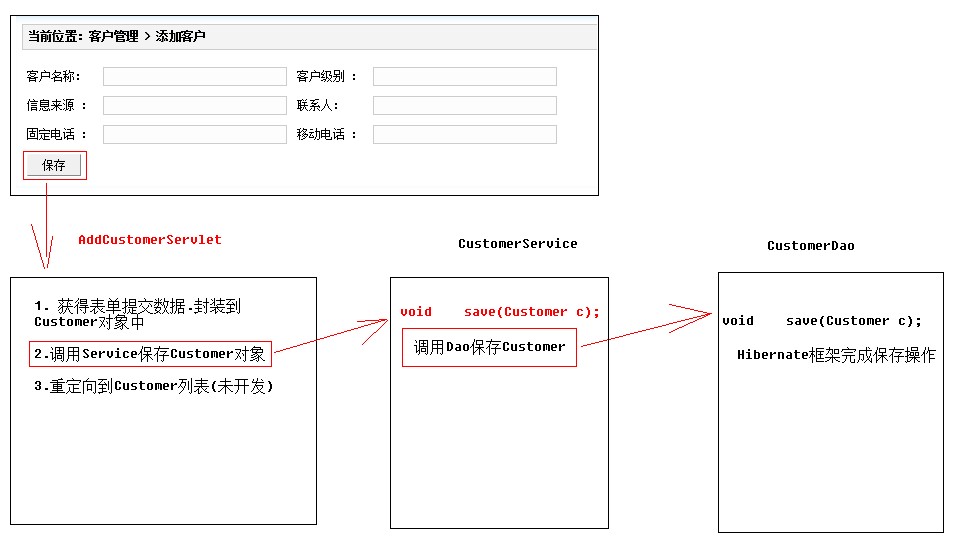
(此项目,依然是在之前struts2和crm项目的基础上进行添加)
<?xml version="1.0" encoding="UTF-8"?> <web-app xmlns:xsi="http://www.w3.org/2001/XMLSchema-instance" xmlns="http://java.sun.com/xml/ns/javaee" xsi:schemaLocation="http://java.sun.com/xml/ns/javaee http://java.sun.com/xml/ns/javaee/web-app_2_5.xsd" id="WebApp_ID" version="2.5"> <display-name>test_struts2</display-name> <filter> <filter-name>struts2</filter-name> <filter-class>org.apache.struts2.dispatcher.ng.filter.StrutsPrepareAndExecuteFilter</filter-class> </filter> <filter-mapping> <filter-name>struts2</filter-name> <url-pattern>/*</url-pattern> </filter-mapping> <welcome-file-list> <welcome-file>index.html</welcome-file> <welcome-file>index.htm</welcome-file> <welcome-file>index.jsp</welcome-file> <welcome-file>default.html</welcome-file> <welcome-file>default.htm</welcome-file> <welcome-file>default.jsp</welcome-file> </welcome-file-list> <filter> <filter-name>encodeFilter</filter-name> <filter-class>cn.itheima.web.filter.GenericEncodingFilter</filter-class> </filter> <filter-mapping> <filter-name>encodeFilter</filter-name> <url-pattern>/*</url-pattern> </filter-mapping> <servlet> <description></description> <display-name>AddCustomerServlet</display-name> <servlet-name>AddCustomerServlet</servlet-name> <servlet-class>cn.itheima.web.AddCustomerServlet</servlet-class> </servlet> <servlet-mapping> <servlet-name>AddCustomerServlet</servlet-name> <url-pattern>/AddCustomerServlet</url-pattern> </servlet-mapping> </web-app>
PS:引入了struts2,依然还可以在web.xml文件之上配置filter和servlet
通过/test_struts2/WebContent/jsp/customer/add.jsp进行请求调用
中文乱码处理过滤器
(以后可以一直用)
import java.io.IOException; import java.io.UnsupportedEncodingException; import java.util.Map; import javax.servlet.Filter; import javax.servlet.FilterChain; import javax.servlet.FilterConfig; import javax.servlet.ServletException; import javax.servlet.ServletRequest; import javax.servlet.ServletResponse; import javax.servlet.http.HttpServletRequest; import javax.servlet.http.HttpServletRequestWrapper; /** * 通用编码解决方案 * */ public class GenericEncodingFilter implements Filter { public void destroy() { } public void doFilter(ServletRequest request, ServletResponse response, FilterChain chain) throws IOException, ServletException { // 转型为与协议相关对象 HttpServletRequest httpServletRequest = (HttpServletRequest) request; // 对request包装增强 HttpServletRequest myrequest = new MyRequest(httpServletRequest); chain.doFilter(myrequest, response); } public void init(FilterConfig filterConfig) throws ServletException { } } // 自定义request对象 class MyRequest extends HttpServletRequestWrapper { private HttpServletRequest request; private boolean hasEncode; public MyRequest(HttpServletRequest request) { super(request);// super必须写 this.request = request; } // 对需要增强方法 进行覆盖 @Override public Map getParameterMap() { // 先获得请求方式 String method = request.getMethod(); if (method.equalsIgnoreCase("post")) { // post请求 try { // 处理post乱码 request.setCharacterEncoding("utf-8"); return request.getParameterMap(); } catch (UnsupportedEncodingException e) { e.printStackTrace(); } } else if (method.equalsIgnoreCase("get")) { // get请求 Map<String, String[]> parameterMap = request.getParameterMap(); if (!hasEncode) { // 确保get手动编码逻辑只运行一次 for (String parameterName : parameterMap.keySet()) { String[] values = parameterMap.get(parameterName); if (values != null) { for (int i = 0; i < values.length; i++) { try { // 处理get乱码 values[i] = new String( values[i].getBytes("ISO-8859-1"), "utf-8"); } catch (UnsupportedEncodingException e) { e.printStackTrace(); } } } } hasEncode = true; } return parameterMap; } return super.getParameterMap(); } @Override public String getParameter(String name) { Map<String, String[]> parameterMap = getParameterMap(); String[] values = parameterMap.get(name); if (values == null) { return null; } return values[0]; // 取回参数的第一个值 } @Override public String[] getParameterValues(String name) { Map<String, String[]> parameterMap = getParameterMap(); String[] values = parameterMap.get(name); return values; } }